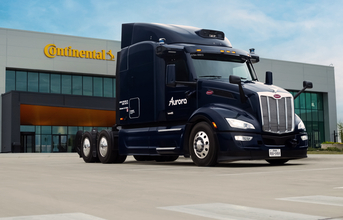
Continental and Aurora Innovation have finalised the design and architecture of the future fallback system and hardware of the Aurora Driver, an SAE (Society of Automotive Engineers) Level 4 autonomous driving system that Continental plans to start production of in 2027. The finalised hardware design comes less than a year after the companies entered a partnership aimed at high-volume manufacturing of autonomous trucking systems.
Aurora has teamed up with Continental to jointly develop reliable, serviceable, and cost-efficient autonomous hardware kits for mass production. The partnership gives Aurora a path to deploy autonomous trucks at scale after its initial driverless launch, planned at the end of 2024. The future Aurora Driver will be designed to deliver customer value for one million miles.
"Technologies for autonomous mobility present the biggest opportunity to transform driving behaviour since the creation of the automobile," said Philipp von Hirschheydt, Executive Board Member, Automotive Group Sector, Continental. "Achieving this milestone puts us on a credible path to deploy easy-to-service autonomous trucking systems that customers demand."
Aurora is also working with Continental to provide an industrialised fallback system that is expected to go into production in 2027. To operate safely without a human driver, autonomous vehicles require built-in redundancies that provide backups in the rare case a component or sensor fails. One of these redundancies is the fallback system, a specialised secondary computer that can take over operation if a failure occurs in the primary system. This innovative dual engineering approach is intended to reduce the exposure of the main and fallback systems to single points of failure.
"From day one, we knew we'd need to build a strong ecosystem of partners to bring this technology to market safely and at a commercial scale," said Chris Urmson, Co-Founder and CEO, Aurora.
The Path to the Start of Production in 2027
The four-year partnership roadmap includes:
2023: Blueprint and Design: Aurora and Continental have aligned on the detailed system architecture, key requirements, and detailed technical specifications of the Aurora Driver hardware.
2024-2025: Build and Test: Continental will build initial versions of the hardware for testing at its new facility in New Braunfels, Texas, USA, and across its global manufacturing footprint.
2026-2027: Finalisation, Start of Production, and Integration: Continental will industrialise and validate the future Aurora Driver hardware and fallback system before the start of production at its facilities. The hardware will leverage Continental's automotive product portfolio, including sensors, automated driving control units (ADCU), high-performance computers (HPC), telematics units, and more. The hardware and fallback system will be shipped to Aurora's trucking manufacturing partners for integration into autonomous-ready vehicles. During this phase, the companies will also develop a service playbook and maintenance network for Aurora's customers.
2027 and beyond: Deployment at Scale: Thousands of trucks integrated with the Aurora Driver are ready to autonomously haul freight across the U.S.
Von Hirschheydt added, "Being the industry's only tier-one supplier with a commitment to industrialise autonomous hardware kits at scale allows us to be at the forefront of and capitalise on this ground-breaking technology."


























